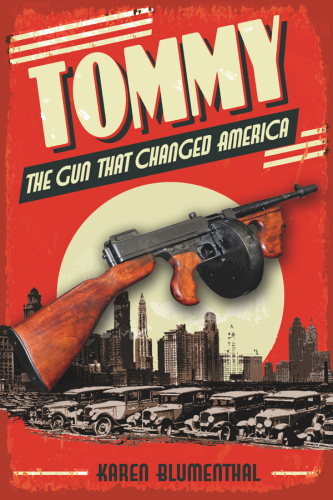
Tommy
The Gun That Changed America
فرمت کتاب
ebook
تاریخ انتشار
2015
Lexile Score
1180
Reading Level
7-10
ATOS
8.3
Interest Level
4-8(MG)
نویسنده
Karen Blumenthalناشر
Roaring Brook Pressشابک
9781626720855
کتاب های مرتبط
- اطلاعات
- نقد و بررسی
- دیدگاه کاربران
نقد و بررسی

Starred review from April 20, 2015
The Thompson rapid-firing submachine gun is the crux of Blumenthal’s accessible social history, which encompasses military weaponry, gangster warfare, and gun-control legislation. A chronicle of the development and manufacturing of the Tommy gun, designed by army ordnance officer John T. Thompson for use in WWI trench warfare, leads into an engrossing and grisly account of the gun’s use as “the trademark weapon of Chicago’s bad boys” (rival bootlegging gangs) during Prohibition. In one of several ironic twists, Blumenthal (Steve Jobs: The Man Who Thought Different) notes that, unlike pistols or revolvers, the larger and more lethal Tommy gun was not covered by concealed-weapons laws, and could be easily purchased at sporting goods and hardware stores. The pace further accelerates with the appearance of brazen Depression-era armed bandits, most notably John Dillinger, whose capture became J. Edgar Hoover’s top priority. Mug shots and graphic crime scene photos highlight the lawlessness of the period, while an epilogue discussing comparatively recent shootings and legislation emphasizes that the questions raised by the appearance of weapons like the Tommy gun are far from resolved. Ages 12–up. (June)■

Starred review from April 15, 2015
John T. Thompson created the submachine gun that bore his name but was distressed when the "impressive little killing machine" he intended for war became the deadly weapon of choice for Prohibition-era gangsters. The Tommy gun, as it was nicknamed, was hand-held, "roughly the size of a new baby," and could fire 800 bullets per minute. Such a gun would have been a devastating weapon in the trenches of World War I, a potential " 'trench broom.' A gun to sweep away the enemy." Instead, it was loved by the likes of Machine-gun Kelly, Pretty Boy Floyd, and Baby Face Nelson, and their reign of gang violence was glorified in the movies of the 1930s; to some, they were heroes fighting against bankers blamed for the Great Depression. Blumenthal's fascinating biography of the weapon is most dramatic in its chapters on the famous gangsters, as might be expected. It's also a fair-minded analysis of what the Second Amendment intended and what society might do to curb criminal gun violence while respecting the rights of individuals to keep guns. Lively prose, well-selected photographs, and thorough source notes round out this fine work. A gripping look at guns, gangsters, and finding the "right balance between individual freedom and community safety." (Nonfiction. 12-18)
COPYRIGHT(2015) Kirkus Reviews, ALL RIGHTS RESERVED.

Starred review from June 1, 2015
Gr 6 Up-The history of the Thompson submachine gun is the story of a tumultuous period in American history, marked by Prohibition, the Great Depression, two world wars, and violence. Originally developed by John Thompson as a lightweight, automatic rifle to be used by American soldiers, the Tommy gun was invented in 1918-too late for mass distribution during World War I-and wasn't officially adopted by the U.S. Army until World War II. Very quickly, however, the gun that was "built for the battlefield, turned loose on the American streets" became popular with gangsters, bank robbers, strike busters, and others who appreciated its compact size and ability to spray hundreds of bullets in a matter of seconds. Attempts to limit distribution of such a powerful weapon to law-enforcement and military personnel were stymied and, in some cases, opposed by groups who supported the right to bear arms. A discussion of the development of gun control legislation is woven throughout the book, and an extensive bibliography and source notes are appended. Blumenthal breathes life into this seemingly off-putting subject, relating individual cases in which the Tommy gun made history and delving into the exciting tales of notorious gangsters while still maintaining an unbiased, objective approach. The book's many photographs and illustrations add to its appeal. VERDICT This action-packed title will hold the attention of reluctant readers and history buffs alike.-MaryAnn Karre, West Middle School, Binghamton, NY
Copyright 2015 School Library Journal, LLC Used with permission.

Starred review from June 1, 2015
Grades 8-11 *Starred Review* As she did in her Sibert Honor Book Six Days in October (2003) and Bootleg (2011), Blumenthal offers up a fascinating study of America in the 1920s and 1930s. During the Prohibition era, the Thompson submachine gun became as infamous as the gangstersAl Capone, John Dillinger, and George Machine Gun Kelly, to name a fewwho wielded violence with it. Peppered with action-filled scenes and period photographs, this account traces the history of the early automatic weapon and its continuing impact on American society. Its creator and namesake, Lieutenant Colonel John Thompson, envisioned American soldiers with light, automatic rifles that could be used in trench warfare, but by the time Thompson was able to manufacture and sell the weapon in 1918, WWI was coming to a close. Soon the surplus tommy guns made their way into the hands of criminals. In engaging and original prose, Blumenthal describes how the early twentieth-century crime sprees eventually caught national attention and were glorified in Hollywood movies. The ensuing war on crime not only shaped the career of J. Edgar Hoover but also initiated some of the first gun legislation and triggered debate over Second Amendment rights. The questions the tommy gun raised are still up for discussion. This thoroughly researched, compulsive read is another Blumenthal winner. A bang-up look at American history.(Reprinted with permission of Booklist, copyright 2015, American Library Association.)

























دیدگاه کاربران